tropical wildstyle graffiti
tropical wildstyle graffiti
On this recent interview with Stinkfish as part of a selection of unique artworks currently featured, the artist shared some of his insights, process of creation and his view on the evolving graffiti scene in Latin America and beyond.
tropical wildstyle graffiti
tropical wildstyle graffiti
On this recent interview with Stinkfish as part of a selection of unique artworks currently featured, the artist shared some of his insights, process of creation and his view on the evolving graffiti scene in Latin America and beyond.
tropical wildstyle graffiti
tropical wildstyle graffiti
On this recent interview with Stinkfish as part of a selection of unique artworks currently featured, the artist shared some of his insights, process of creation and his view on the evolving graffiti scene in Latin America and beyond.
Wandering the streets of Bogotá a decade ago, I began spotting the colossal and colorful murals of Stinkfish. His distinctive style, often described as a fusion of contemporary culture and ancient traditions, has been defined by the artist himself as “a blend of photography, tropical wildstyle graffiti, and stencils.”
Stinkfish’s signature spray-painted stencils come alive through bold color fields and intricate freehand detailing. His works spotlight anonymous passersby and local residents, transformed into vibrant portraits.
01. Anonymous passersby
Stinkfish My portraits explore how public spaces reflect social inequality, where visibility in public spaces often belongs to those who can afford it. My selection of photographs is guided by a commitment to anonymity and equality. It’s also important to me that the photos are unposed, taken from a respectful distance, and feature people I don’t know, capturing everyday moments where expressions aren’t forced or conditioned. These photographs will become my candid portraits to take into public spaces, on the street which can be a space open to the representation of everyone.
ES « Mi trabajo con retratos tiene que ver con el espacio público, con las maneras de representanción en la calle, donde por lo general las personas que figuran son aquellas que pagan por estar allí. La elección de las fotografías en mi trabajo está atravezada por el anonimato y la igualdad, todos podemos estar representados en este espacio, la calle. Y en una segunda instancia es importante que sean fotos sin pose, donde el momento sea real y cotidiano, donde la expression no esté condicionada. Geralmente son fotografías tomadas en la calle, en lugares públicos, a una distancia prudente, y de personas que no conozco. »
Born in the megalopolis of Mexico City, also known for its gigantic urban art and graffiti scene. Stinkfish grew up from the age of four in Bogotá (Colombia), a place where he built his life, his art, friendships, and various projects. This typical Latin American capital, which he describes as a fairly large city—chaotic at times, aggressive at others—is his home, a place where he finds time to organize ideas, rest, and disappear from time to time.
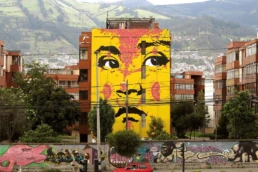
Chiriyacu – Quito, Ecuador | the Detonarte festival – December 2015 (Based on a photograph taken in Oaxaca, Mexico // october 2014)
On his blog, Stinkfish shares various insights, including one in which he discusses Decree 075—a regulation on graffiti issued by the Bogotá district in 2013. In this article, the artist reflects on how troubling it is that the collective imagination surrounding graffiti can be reshaped, erasing its roots as a form of escape from the grip of institutions and consumer culture in its early days.
Practically speaking, the experience of graffiti remains unchanged. For Stinkfish, it continues to serve as a tool for critical awareness—for questioning our reality, institutions, laws, and the collective life we all share.
*[Mention: “LA CIUDAD QUE FALLA / Apuntes sobre Graffiti en Bogotá”, LA CIUDAD QUE FALLA / Apuntes sobre Graffiti en Bogotá – stinkfish.024 / Ediciones Hogar (wordpress.com)]
With each mural, Stinkfish captures flickers of humanity behind the eyes of everyday people across the globe. Though he is sometimes labeled an “artist-anarchist,” his work moves beyond rebellion, rooted instead in a nuanced exploration of society, questioning our reality, and place.
02. How do you feel to be sometimes labelled as an ‘artist-anarchist’?
Stinkfish I don’t like labels; they fall short and oversimplify people—they ignore the complexity of thoughts, experiences, and identities each of us holds. I believe that graffiti, beyond being an artistic movement, it’s a tool for building critical awareness of the world we live in. From there, I aim to keep consistency across my work, ideas, relationships, and opinions.
ES « No me gustan las etiquetas, se quedan cortas al momento de afrontar la realidad, somos muchos en uno mismo. Creo que que el graffiti más allá de un movimiento artístico es una herramienta para construir una posición crítica frente al mundo en el que vivimos, desde ahí intento ser congruente con mi trabajo, con mis ideas, con mis relaciones, con mis opiniones. »
Beijing (Pekin), China | August 2015 | Collaboration with Robbbb (Based ona photo taken at the airport El Dorado // Bogota // Colombia // April 2014)
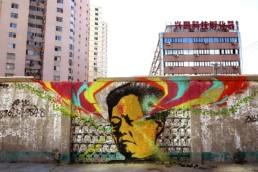
03. Graffiti connections.
Stinkfish I got my start with some friends in the legendary Excusado Printsystem crew, while developing my own practice. I’m now part of the Animal Power Culture (APC) crew and also involved in the Instituto Bogotano de Corte (IBDC) project. I’ve always enjoyed wandering the streets—getting lost, discovering new places, and observing the city’s chaotic rhythms. Graffiti is all about wandering. Once I got to know graffiti up close, I knew it was the path I wanted to follow—one that would allow me to understand the world in a sincere way. There isn’t a grand story behind my pseudonym. During my teenage years, ska, punk, and hardcore musics were a part of my daily life, and I believe that was the main influence behind choosing the name Stinkfish.
ES « Siempre me ha gustado la calle, caminar, perderme y conocer nuevos lugares, observar como funciona el caos de las ciudades. Y el graffiti es eso: caminar. Una vez conocí el graffiti de cerca supe que era el camino que quería tomar, que me permitiría entender el mundo de una manera sincera. No hay una gran historia detrás de mi seudónimo, cuando cruzaba la adolescencia el ska, el punk, el hardcore hacián parte de mi día a día, creo que esa fue la principal influencia al momento de hacerme llamar Stinkfish. Arranqué con un grupo de amigos, con el legendario grupo Excusado Printsystem, pero también haciendo mi trabajo individual de manera muy intensa. Ahora hago parte del crew Animal Power Culture (APC) y también del Proyecto Instituto Bogotano de Corte (IBDC). »
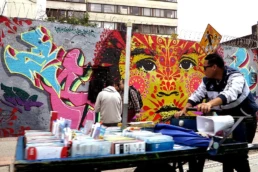
Bogotá, Colombia | May 2018 | Collaboration with Zasinha @thegruffwriting
Colombia-based street artist Stinkfish gained international recognition for his colorful and large-scale murals. His work spans continents, appearing on walls across Colombia, Mexico, Peru, Ecuador, Chile, Bolivia, Guatemala, Spain, Germany, the UK, France, Holland, the USA, Austria, Nepal, China, and beyond.
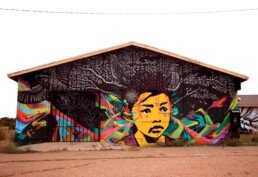
Navajo Nation – Arizona, USA | September 2015 | Collaboration with KillJoy & Mazatl for The Desert Painted Project (Based ona photo taken in Boeung Kak // Phnom Penh // Cambodia // march 2015)

Londres, the UK | July 2011
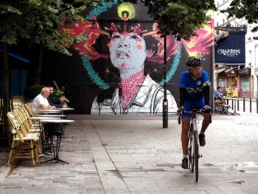
Paris, France | June 2018 | @lemuroberkampf (Based on a photograph taken in Xi’an // China // July 2016)

A photograph found on the streets of Shanghai, China | July 2016 | Mural at the National University – Bogota, Colombia | September 2016 | Collaboration with Empty Boy
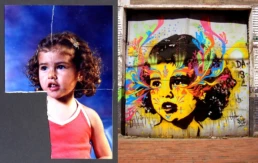
A photograph found on the Barrio Teusaquillo – Bogotá, Colombia | September 2010 | Mural in the Barrio Santa Fe – Bogotá, Colombia | October 2010
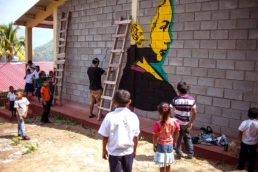

Sabio Valle School – Las Delicias – Intibucá, Honduras | May 2016 (Based on photograph taken at Tijuana // Baja California // México // june 2015)

From the portrait Pioneer Girl of Aleksandr Rodchenko (1930)
| Mural in Moscow, Russia | September 2014
©All photographies by Stinkfish

